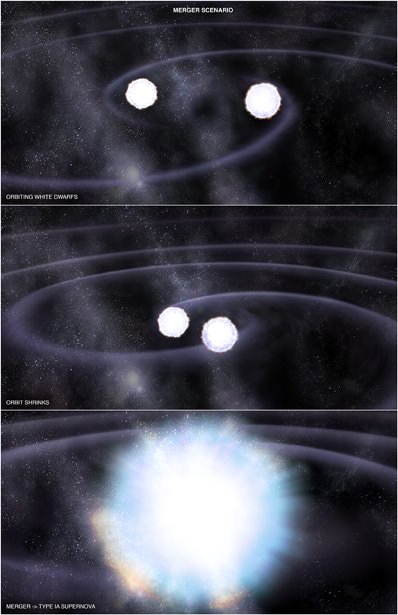The folks over at PHD Comics have put together a new video in their Two-Minute Thesis series, this one featuring Ph.D candidate Or Graur of the University of Tel Aviv and the American Museum of Natural History discussing the secret lives — and deaths — of astronomers’ “standard candles” of universal distance, Type Ia supernovae.
Judging distances across intergalactic space isn’t easy, so in order to figure out how far away galaxies are astronomers have learned to use the light from Type Ia supernovae, which flare up with the brilliance of 5 billion Suns… and rather precisely so.
Type Ia supernovae are thought to be created from a pairing of two stars: one super-dense white dwarf which draws in material from a binary companion until a critical mass — about 40% more mass than the Sun – is reached. The overpacked white dwarf suddenly undergoes a rapid series of thermonuclear reactions and explodes in an incredibly bright outburst of material and energy.
But exactly what sorts of stellar pairs lead to Type Ia supernovae and how frequently they occur aren’t known, and that’s what Ph.D candidate Or Graur is aiming to learn more about.
Read more: A New Species of Type Ia Supernova?
“We don’t really know what kind of star it is that leads to these explosions, which is kind of embarrassing,” says Graur. “The companion star could be a regular star like our Sun, a red giant or supergiant, or another white dwarf.”
Because stars age at certain rates, by looking deeper into space with the Hubble and Subaru telescopes Graur hopes to determine how often and when in the Universe’s history Type Ia supernovae occur, and thus figure out what types of stars are most likely responsible.
“My rate measurements favor a second white dwarf as the binary companion,” Graur says, “but the issue is far from settled.”
Watch the video for the full story, and visit PHD TV and PHD Comics for more great science illustrations.
Video: PHDComics. Animation: Jorge Cham. Series Producer: Meg Rosenburg. Inset image: merging white dwarfs causing a Type Ia supernova. (NASA/CXC/M Weiss)

